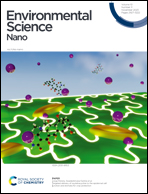Waste tailing particle electrode enables enhanced electrochemical degradation of sulfamethoxazole†
Abstract
In the electrocatalytic (EC) degradation process, low current efficiency, mineralization efficiency, and mass transfer efficiency have limited its widespread application. To overcome these limitations, spherical particle electrodes (LZT–SO) with high electrocatalytic activity were simply prepared by using lead–zinc tailings (LZT) as catalytically active substances and soil (SO) from riverbeds as the carrier. The LZT–SO electrode was introduced into an electrocatalytic (EC) reaction tank to establish a three-dimensional catalytic oxidation system (EC/LZT–SO). Compared with the EC (0.0118 min−1) and EC/SO (0.0271 min−1) systems, the EC/LZT–SO system exhibited a higher sulfamethoxazole (SMZ) degradation rate (0.0597 min−1). EPR analysis and free radical capture experiments confirmed that ·OH played a major role in the degradation process. SEM + EDS analysis confirmed that Fe and Mn metal oxides were the main active sites of the LZT–SO electrode. Under complex water conditions, the degradation efficiency of SMZ reached 94–100% within 70 min. Even after three cycles, the EC/LZT–SO system still maintained a high removal efficiency of 93.75% for SMZ, with only a slight decrease of 6.25%. Triple quadrupole liquid chromatography-mass spectrometry (LC-MS) and Toxicity Estimation Software Tool (TEST) software were used to study the products after SMZ degradation and it was found that the products were almost harmless. This work will provide a new perspective for the “treat waste with waste and turn waste into treasure” approach, which can accelerate the development of recycling waste tailings.



 Please wait while we load your content...
Please wait while we load your content...